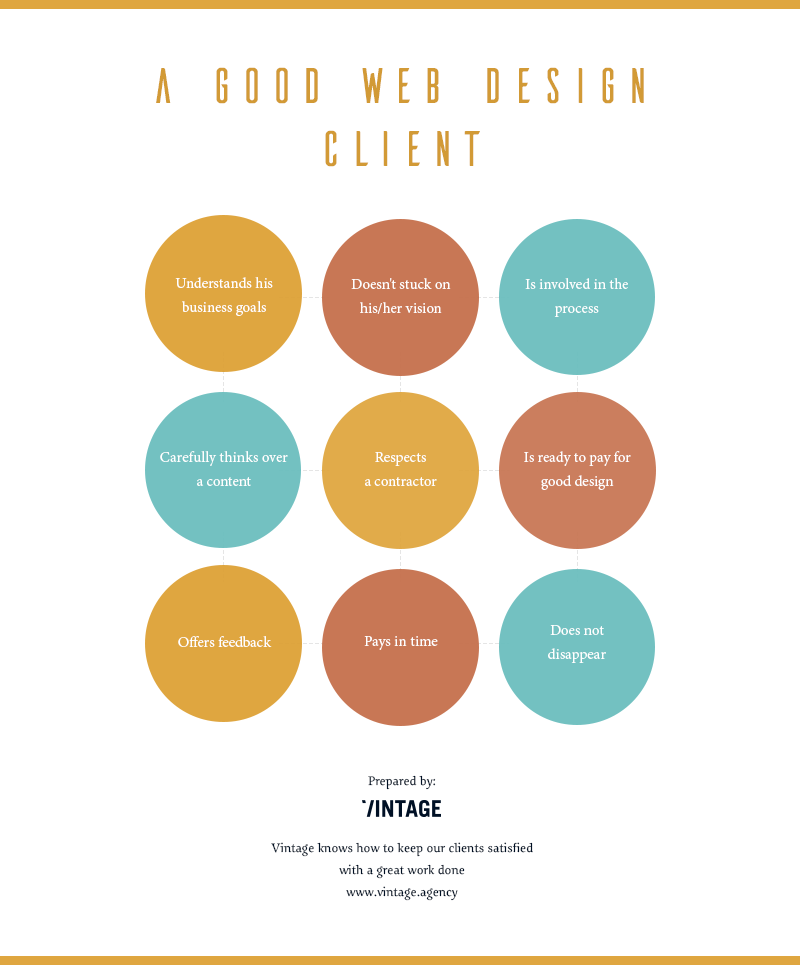Everyone wonders how to find a good web designer, but have you even thought about how to be a good web design client? Most likely not, judging by the number of irritated designers telling stories about their experience of working with frustrating clients.
Were you unsatisfied after you got a bunch of cow dung instead of the web design perfection you demanded? Have you ever refused to pay for a website which eventually turned to be crappy because of misunderstanding between you and your designer? Oh, how many times web design clients failed to develop the best website because of their own fault.
Who is this mystical “good client” and why is it important to be him? You probably suspected it before, but I would like to say it again: creating of any website is a work of equal two - a web agency and a client. In fact, designing and coding are probably the easiest parts of the gig. Learning how to deal with clients and how to handle the business part of it are much, much harder. Another problem is that when a client hires a web agency, he simply does not know how to work with the web developers.
However, the only reason there are “bad clients” in the world is that because “bad designers” took them on. As a co-founder and design director of Mule Design Mike Monteiro once said: “Client feedback has a way of taking you to places you never dreamed you’d go.”
In this article, I’ve tried to highlight nine key features of a good client which greatly facilitate the web design process and usually help to get stunning results. It will help you to understand the difference between a good client and a bad one and to probably reconsider your view of a good client-designer relationship.

A good client understands his business goals and knows who his target customer is. Being concise and clear with ideas is the most important thing a client can do. If a client cannot articulate the concept of his business, the website will suffer. A bad client fails when looking at a completed website in terms of his own preferences.
Let’s admit that one decided to create an online-shop for building materials & supplies. If he used to be a builder for 20 years, then his opinion is representative and relevant. But if he sells rubberoid and consults on the website with his wife or secretary who have never bought (or even seen) rubberoid, such advice are not very helpful. In short, a good client can abstract from what he likes or dislikes and keeps in mind that he creates a website for his client rather for himself.
This does not apply to artists and musicians - they develop websites primarily for themselves. They are hard but very interesting clients: hard because not every web agency is willing to work with them and interesting because an agency has a great chance to create something outstanding. Mediocre and unprofessional web agencies often fails on that kind of projects and leave their clients unsatisfied with the results.
A good client shares but does not stuck on his vision of the future website. He can say he wants “more gray” or “less green,” but, besides that, he should see which business goals are not implemented. Only then a client and a designer, working together, could fill the holes. On the other hand, if a client points out how to do without consulting with a designer, the latter will renown a project sooner or later - he’ll simply cease to worry about it.
Ben Groulx described it perfectly: “Of course, your personal preferences may be difficult to see past - “I hate orange! This will not work!” - however design is not a matter of taste. It is about producing systems, pieces, structures, and stories that perform well.”
At Vintage, we are finding common ground with 95 percent of clients contacted us. The main reason the remaining 5 percent are rejected is because they make strange demands. The Clients From Hell website complains about a lot of weird, unreasonable client’s requests. We could add a lot more to the list. However, every client is different, and each needs a certain approach. And sometimes, even the most bizarre demand from a client can turn into a fresh, amazing idea in a designer’s head.
A good client is involved in the process as much as possible, at least at initial stages. He has to participate in everything and be aware of concepting, Information Architecture, user journey design, and stuff like that. His role is to help facilitate the first part of the designer’s job clearly describing your business goals to the designer. The better the designer understands a task, the more precisely he could achieve the results the client envisioned.
A good client carefully thinks over a content: texts, audio and video materials, photos. There are two ways for a client to organize the process: he either comes to a web agency with a prepared contentб or he hires a web designer, brief a project, figures out what kind of content would be needed, and sets an additional budget for content production.
The more organized a client is with his content, the better a designer will be able to lay it out for him. A bad client requests to make a website without a content or fails to provide it in time. And, when the content is finally created, a website inevitably turns from good into mediocre.
A good client respects a contractor. The relationship with your contractor should be built on mutual respect. In other case, it will eventually lead to nothing. If a contractor does weak work, a client pays for worked hours and says goodbye to the agency. But he still behaves respectively.
An agency should feel secure and be sure that their additional investments and efforts will be recognized accordingly.
A good client may not know what he wants but is ready to pay for getting what he wants. It is okay to go with “I know it when I see it” mindset, but a good client knows that when he will “see” this, the work has to be done and be fairly paid. But if he wants he does know what, web agencies usually work with such clients on fixed costs rather than iteration.
Designers can remake a website again and again, but only if a client is ready to pay for it. And such client is still a good one - he is entitled to find himself. But if he wants to pay for 50 designs as for 3, none of the web agencies will take up the project. For example, before completing the website for Ukrainian interior designer Sergey Makhno, designers at Vintage have drew a dozen of different design concepts. It costed him nearly $100,000, but the ultimate result was worth every penny.
There are certain reasons why one designer works for $10/hour while another one - for $100/hour. And you probably guess why it is so. If a client looks for professionalism and quality, he should be prepared to pay for them.
A good client offers regular and useful feedback throughout the post-launching process and tells an agency how the website influenced the life of his brand. This allows the agency to improve their work and to give a correct feedback.
A good client pays in time. He understands that if he changes a brief or terms, it should be paid for.
- A good client does not disappear all of a sudden. An agency always plans its work time, so if a client vanishes for two weeks, the web agency pauses a project. It means that it cannot suddenly start working on it.
Anyway, a designer’s career is a precipitous learning curve. Both good and bad clients are an integral part of that curve. Sometimes the process is hard, but each web design client for us is our new step we’ve made and new things we’ve done better.
If each of these points described below is about you, you are probably either cunning or has never dealt with a web designer. In other case, you undoubtedly deserve the best web agency, such as Vintage. Contact us - let your the most bold ideas to come true.

View Comments